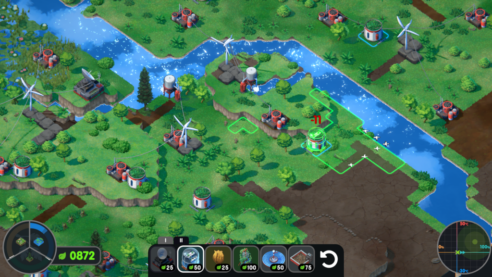
Press Restart for Planet Earth
As a city builder, Terra Nil challenges conventions in a deeply satisfying way, but its environmental messaging doesn’t always hold water. Its restorative, puzzle-like loop of cleansing the earth and seas and reinstalling natural biomes is a relaxing fantasy. You return corals to the ocean, and forests to fallow ground at the click of a button where in other games you might be zoning factories or housing, but it’s an environmental fantasy that comes with a catch.
The worst case scenario has already come to pass: this is a world after climate disaster, uninhabitable for humans (and before your intervention, where flora and fauna are hanging on by a thread). And so the restorative work that you engage in comes with the caveat that it is incompatible with human coexistence.
While I believe Terra Nil is mostly trying to avoid answering questions about where people are in its setting – which would require either fantastical worldbuilding or deeply sinister implications – its intentional ambiguity carries its own implications. If nothing else, that people are distinct from nature, that we are apart from ecosystems, that there is something inherently adverse about human life.

It’s a narrative that became particularly popular during the early period of the pandemic. While many of us were in lockdown, there were frequent posts and headlines declaring that “nature was healing” when animals were seen as “returned” to urban areas. Even when it wasn’t true, there was something comforting about the idea that, while we were suffering, swans were coming back to Venice – when in fact, even urban ecosystems include many animals, including those that depend on human foot traffic (our part in that ecosystem) to eat.
The idea that the impact of humans is inherently destructive becomes, paradoxically, a way to evade responsibility. It’s easier to state that one day, humans will – through conveniently ambiguous means – be ‘gone’ and the Earth will heal itself, instead of taking action to negate the impacts of climate change now. And while human exceptionalism is deeply unhelpful from a conservation point of view, it’s also borne from only one specific cultural viewpoint on our relationship to nature, where many cultures notably hold a more synergistic view.
While Terra Nil doesn’t quite heal itself, its ideal is close to that. You undo the damage, clean up the signs that you were ever there, and leave behind a self-sustaining ecosystem. You could believe that this was what was there “before” – not just the hundred or so years of industrial contributions to global heating, but the hundreds of thousands of years where humans lived on Earth. Terra Nil: a full reset.
As a game, Terra Nil works beautifully towards its environmental theming, and it exists as a reflection of the city builder genre’s own assumptions about exploitation and limitless resources. I’m left wondering, however, if the core of its fantasy isn’t similarly faulty. Is the idea of a full reset actually desirable or useful to spend time with? Or does Terra Nil instead offer a space to assuage guilt about the complexity of being a person on a changing planet?
———
Ruth Cassidy is a writer and self-described velcro cyborg who is between internet homes. You can find their portfolio at muckrack.com/velcrocyborg.





